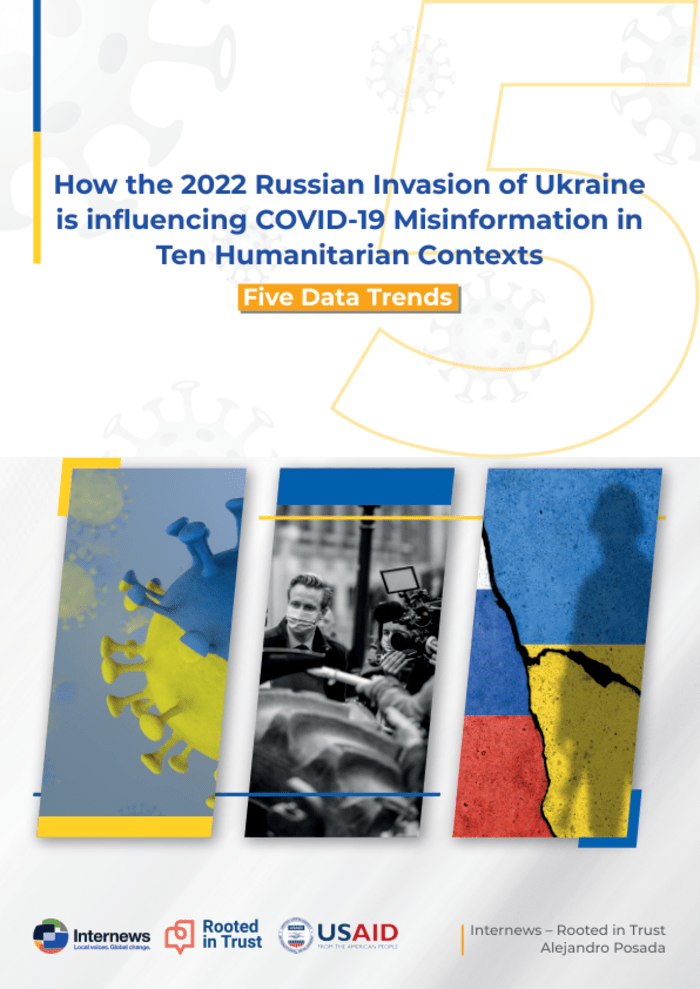How the 2022 Russian Invasion of Ukraine is influencing COVID-19 Misinformation in Ten Humanitarian Contexts: Five Data Trends – Ukraine

Internews – Rooted in Trust
Alejandro Posada
INTRODUCTION
Rooted in Trust (RiT) is a global pandemic information response program countering the unprecedented scale and speed of the spread of rumors and misinformation related to COVID-19 in Lebanon, Mali, Colombia, Sudan, Brazil, the Democratic Republic of Congo, Iraq, Afghanistan, South Sudan and Zimbabwe (see the website). Within Internews we define rumors as an unverified qualitative piece of information documented from a first-hand source within the community. Our rumor tracking methodology allows us to analyze community feedback to understand and respond to the hopes, fears, questions and concerns that often propel the spread of misinformation.
The Russian invasion of Ukraine, beginning on February 24th, received substantial media coverage which some could argue partly shifted global public attention away from the COVID-19 pandemic. Despite the geographic distance between Ukraine and RiT’s countries of focus, we have documented a noteworthy influence of the Ukrainian invasion on the COVID-19 rumor data that we are collecting. Between late February and late May 2022, we collected social media posts and comments consisting of COVID-19 related rumors with a direct mention of the Russian invasion in Ukraine throughout our countries of focus. In response to the collected data, some of our teams have identified and highlighted this new intersection of war and pandemic related rumors (See community bulletins from Lebanon, Iraq, and Sudan).
The purpose of this piece is to present an analysis of the ways in which the Russian invasion of Ukraine has influenced COVID-19 misinformation in several humanitarian contexts based on the data we collected. Though, the data is not meant to be representative of all online conversations or sentiments, rumors can tell us a lot about community concerns, questions, perceptions, and information voids. For this purpose, we analyzed the posts and identified five rumor trends about the intersect of the Russian invasion of Ukraine and the COVID-19 pandemic. The trends collected argue that the Russian invasion of Ukraine demonstrates that:
-
COVID-19 has disappeared or is no longer a priority
-
COVID-19 is, and always was a hoax
-
there is a strategy to divert attention involving COVID-19
-
there are US biological weapons labs in Ukraine
-
there are inconsistencies with the state of COVID-19 infections in Ukraine
These findings are meant to be useful for organizations working on health-related topics with vulnerable communities in humanitarian contexts. The findings give light to community concerns, which organizations can use to create responsive programming and fill information gaps. Additionally, the findings can also contribute to the field of “infodemic” management by setting the stage for future research looking at the implications of current events on a misinformation ecosystem.
A common and recurrent sentiment across all of the trends identified was a concern over the sudden shift in media coverage from COVID-19 to the Russian invasion of Ukraine which sparked debate within our communities and raised accusations of double standards and disproportionate media coverage of the Russian invasion of Ukraine in comparison with other conflicts or issues, particularly in non-western settings (See pieces by Aljazeera and NPR). In many instances, this was accompanied by recurrent critiques of the role of the West, and particularly the United States, in the global pandemic response.
We also identified two particularities of this subset of rumors. The first is that most of the rumors about the Ukraine invasion came from Twitter (51.2%), Facebook (39.5%), and Telegram (3.7%). Whereas, when analyzing the full collection of rumors (including those related and unrelated to Ukraine) during the same period, most rumors came from Facebook (51.1%), Twitter (34%) and YouTube (2.9%). The second is that despite our regular social media and face to face rumor collection we only found cases of rumors about the invasion of Ukraine within our social media data. For more details about the data you can visit our Google data studio.
In this report, we will not identify the origins of the rumors or single out cases of disinformation. However, it is important to mention that there is growing evidence about COVID-19 conspiracy theorists readily adopting pro-Russian disinformation about the invasion (See piece by European Digital Media Observatory and NDTV). The remainder of this report goes into a detailed analysis of each of the aforementioned five major trends identified.


